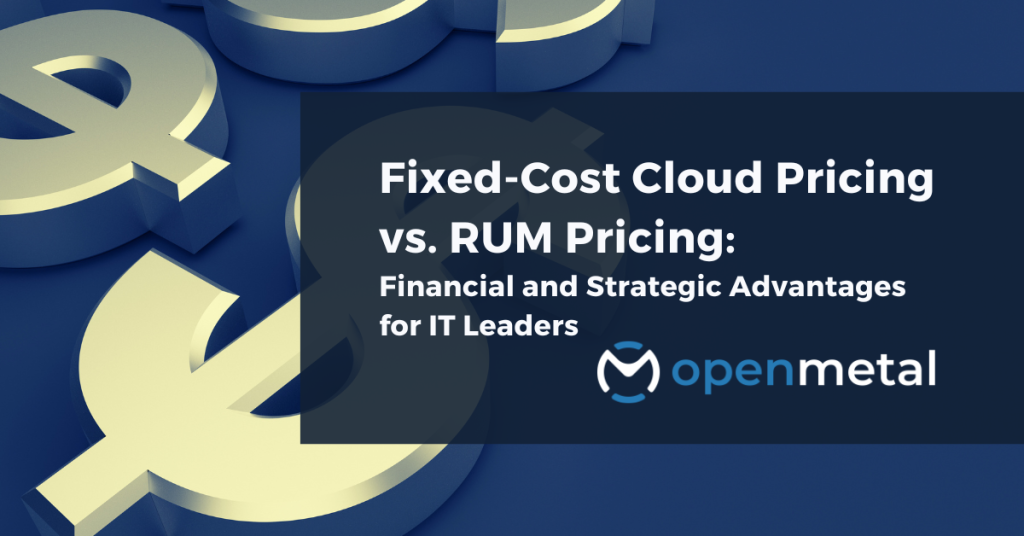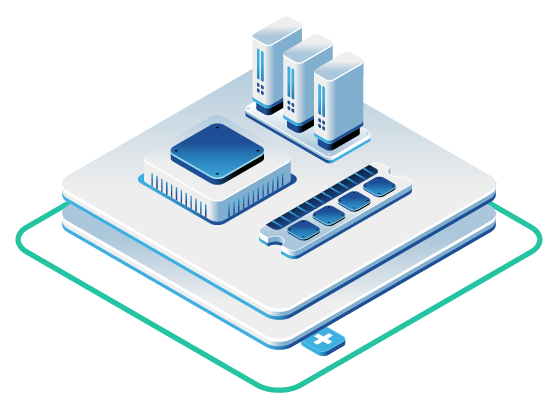
Tired or surprise cloud bills and unpredictable infrastructure costs?
The OpenMetal team is standing by to assist you with scoping out a fixed-cost model based infrastructure plan to fit your needs, budgets and timelines.
The cloud pricing debate has reached a critical inflection point. While Resource Usage Metering (RUM) and consumption-based models promised flexibility, they’ve delivered unpredictable bills, budget overruns, and operational complexity that keeps finance teams awake at night. For IT leaders managing steady or growing workloads, the question isn’t whether cloud infrastructure is necessary—it’s whether variable pricing models serve your organization’s long-term interests.
OpenMetal’s fixed-cost private cloud model presents a fundamentally different approach: predictable monthly costs, transparent billing, and infrastructure designed for sustained performance rather than metered consumption. This isn’t just about saving money—it’s about regaining control over your infrastructure spend while maintaining the scalability and performance your applications demand.
The Hidden Costs of RUM and Usage-Based Pricing Models
Traditional public cloud RUM pricing creates several pain points that compound over time. According to Flexera’s 2024 State of the Cloud Report, organizations waste an average of 32% of their cloud spend, with unpredictable usage patterns driving much of this inefficiency (Flexera, 2024). The seemingly attractive “pay only for what you use” model becomes problematic when your actual usage patterns don’t align with the billing structure.
Egress Fees and Data Transfer Costs Public cloud providers typically charge per-gigabyte for outbound data transfer, creating scenarios where successful applications—those serving more users or processing more data—generate exponentially higher bills. These egress fees can represent 20-30% of total cloud costs for data-intensive applications.
Micro-Billing Complexity RUM models generate thousands of line items across compute instances, storage operations, API calls, and network traffic. This granularity makes cost attribution nearly impossible and forces IT teams to spend valuable time on billing analysis rather than strategic initiatives.
Performance Throttling and Noisy Neighbors Multi-tenant public cloud environments often experience performance variability due to resource contention. When your applications need consistent performance, you end up over-provisioning or purchasing premium tiers to avoid these issues—defeating the cost-efficiency promise of usage-based pricing.
How OpenMetal’s Fixed-Cost Model Works
OpenMetal structures pricing around dedicated “Cloud Core” clusters—minimum three hyper-converged servers that provide predictable monthly costs regardless of your utilization patterns. This approach eliminates the billing complexity and cost volatility inherent in RUM models.
Transparent Public Pricing Calculator Unlike traditional enterprise sales processes that require quotes and lengthy negotiations, OpenMetal provides a fully public, interactive pricing calculator. You can configure clusters, adjust specifications, and view detailed cost breakdowns instantly. This transparency supports accurate budgeting and scenario planning without sales involvement.
No Per-VM or Per-Hour Metering Your monthly cost remains fixed whether you run 10 virtual machines or 100. This pricing structure encourages full utilization of your infrastructure and supports simultaneous development, testing, and production workloads without generating additional line items.
95th Percentile Bandwidth Billing Rather than charging per gigabyte for data transfer, OpenMetal includes substantial bandwidth allowances and measures overages using 95th percentile billing. This approach ignores short-term traffic spikes and can reduce egress costs by 50-80% compared to per-GB public cloud models.
“We designed our pricing model to eliminate the financial friction that prevents organizations from fully utilizing their infrastructure,” explains Yuriy Shyyan, Director of Cloud Architecture at OpenMetal. “When IT teams don’t have to worry about every API call or data transfer generating costs, they can focus on building better applications and driving business value.”
Financial Advantages: Predictability and Lower TCO
Cost Predictability and Budget Certainty Fixed monthly costs enable accurate long-term budgeting and eliminate the uncertainty that plagues RUM-based deployments. According to CloudZero’s 2025 market analysis, organizations using fixed-cost private cloud models report 40-60% better budget accuracy compared to public cloud consumption models (CloudZero, 2025).
Elimination of Proprietary Licensing Fees OpenMetal’s entirely open-source stack—OpenStack for orchestration and Ceph for storage—eliminates recurring licensing fees that can reach thousands of dollars annually per cluster. Organizations migrating from VMware or other proprietary platforms often see immediate cost reductions just from license elimination.
Linear and Predictable Scaling Costs Growth becomes mathematically predictable. Adding capacity means adding nodes at known fixed rates rather than dealing with variable usage surcharges that compound as your applications scale. This predictability supports multi-year strategic planning and accurate ROI calculations for infrastructure investments.
Reduced Administrative Overhead Fixed-cost billing dramatically simplifies cost allocation, chargeback processes, and financial reconciliation. IT finance teams report spending 60-70% less time on cloud cost management when using fixed pricing models compared to complex usage-based billing structures.
Strategic Advantages: Control and Long-Term Alignment
IT-Finance Alignment Fixed costs create natural alignment between IT operations and financial planning. CFOs can budget infrastructure spend as a predictable operational expense rather than managing the variability and unpredictability of consumption-based models. This alignment often leads to faster infrastructure decision-making and reduced friction between IT and finance teams.
Performance Consistency and Dedicated Resources OpenMetal deploys infrastructure on enterprise-grade hardware with dual 10 Gbps NICs, ECC RAM, and all-NVMe storage. Unlike multi-tenant public cloud environments, you receive dedicated resources optimized for both standalone performance and seamless clustering for demanding workloads like AI, analytics, and high-performance computing.
Geographic Control and Compliance Readiness Data centers located in Tier III, SOC 2, and ISO-certified facilities provide geographic options that support data sovereignty requirements and compliance needs. This geographic control becomes increasingly important as regulatory requirements evolve and organizations need certainty about data location and handling.
Vendor Independence and Technical Flexibility The open-source foundation eliminates vendor lock-in concerns while providing API-driven provisioning and orchestration capabilities. You maintain full administrative control over your infrastructure stack without dependence on proprietary platforms or services that could change pricing or terms unilaterally.
Industry Trends: The Movement Toward Hybrid and Cost Transparency
The venture capital community has begun questioning the long-term economics of public cloud dependency. Andreessen Horowitz’s research on cloud economics suggests that companies with significant, stable workloads often achieve better unit economics by moving compute-intensive operations to dedicated infrastructure (Andreessen Horowitz, 2023).
Organizations are increasingly adopting hybrid approaches that combine public cloud services for variable workloads with private cloud infrastructure for predictable, steady-state operations. This hybrid strategy allows you to optimize costs while maintaining access to specialized public cloud services when needed.
The trend toward cost transparency and predictability reflects broader organizational maturity in cloud adoption. Early cloud strategies focused primarily on migration speed and operational agility. Mature cloud strategies balance agility with cost control, performance consistency, and long-term strategic alignment.
Making the Strategic Choice: When Fixed-Cost Makes Sense
Fixed-cost private cloud pricing delivers the greatest advantages for organizations with:
- Steady or predictable workloads that don’t benefit from usage-based pricing volatility
- Data-intensive applications where egress fees represent significant costs
- Compliance or regulatory requirements demanding infrastructure control and data sovereignty
- Development teams needing consistent performance for testing, staging, and production environments
- Finance teams requiring predictable infrastructure costs for accurate budgeting and planning
The decision isn’t simply about choosing the lowest cost option—it’s about selecting the pricing model that aligns with your operational patterns, growth trajectory, and strategic objectives.
Conclusion: Reclaiming Infrastructure Cost Control
OpenMetal’s fixed-cost pricing model represents more than an alternative to RUM-based billing—it’s a strategic approach to infrastructure that prioritizes predictability, transparency, and long-term value creation. While usage-based models may suit organizations with highly variable or experimental workloads, fixed-cost private cloud infrastructure offers compelling advantages for enterprises with steady operations and growth-oriented strategies.
The question for IT leaders isn’t whether you can afford to switch to fixed-cost pricing—it’s whether you can afford to continue managing the unpredictability, complexity, and hidden costs of traditional usage-based models. As cloud adoption matures beyond initial migration concerns, cost predictability and infrastructure control become competitive advantages that directly impact your organization’s ability to plan, scale, and innovate effectively.
Consider conducting a detailed cost analysis comparing your current RUM-based spending against OpenMetal’s transparent pricing model. The results might surprise you—and could fundamentally change how your organization approaches infrastructure investment and planning.
Explore how OpenMetal can help with a PoC Cloud
Start with a risk-free evaluation: Take advantage of OpenMetal’s Proof of Concept program to validate how hosted private cloud can transform your delivery model.
Works Cited
- Andreessen Horowitz. “The Cost of Cloud, a Trillion Dollar Paradox.” Andreessen Horowitz, 2023, a16z.com/the-cost-of-cloud-a-trillion-dollar-paradox/.
- CloudZero. “90+ Cloud Computing Statistics: A 2025 Market Snapshot.” CloudZero Blog, 2025, www.cloudzero.com/blog/cloud-computing-statistics/.
- Flexera. “2024 State of the Cloud.” Flexera, 2024, www.flexera.com/stateofthecloud.
- Flexera. “State of the Cloud Report.” Flexera, info.flexera.com/CM-REPORT-State-of-the-Cloud.
- Spacelift. “How to Migrate from Terraform Cloud to Spacelift.” Spacelift Blog, spacelift.io/blog/how-to-migrate-from-terraform-cloud.







































